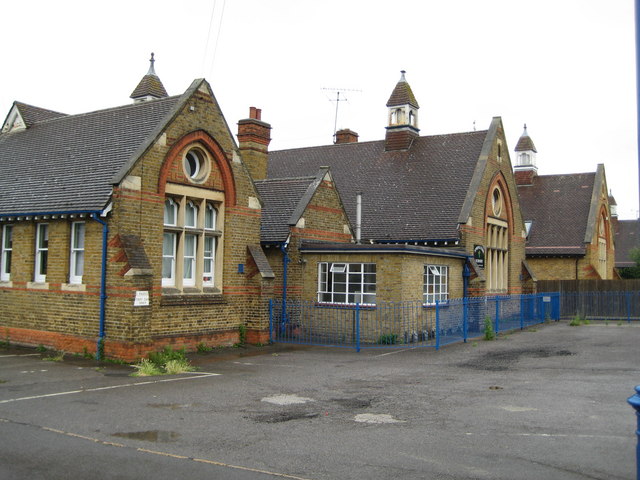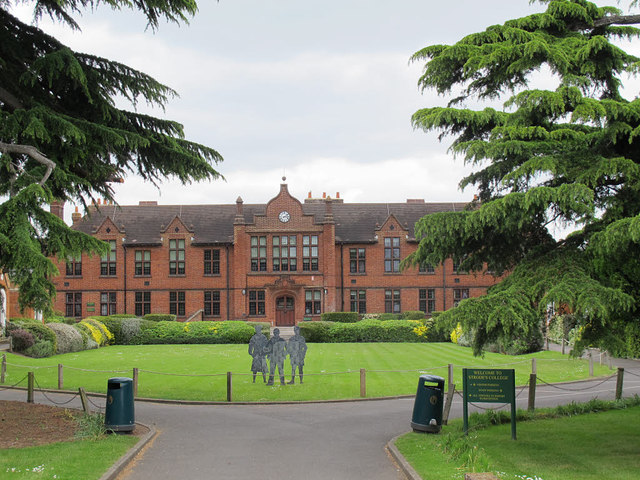Educating Egham Part 1
The first recorded school in Egham seems to have been Strode’s School, built in 1706 from money left by Henry Strode, ‘for the learning and edifying of the poor children of the Parish of Egham …gratis and without fee or reward.’ This came after the Society for the Propagation of Christian Knowledge paved the way in 1699 by opening free schools in some areas for poor children aged 7-11.
Some parents without access to the free schools sent their children to Dame Schools run by women who may have had little or no education themselves. Mrs Lampert ran a Dame School in Armstrong Road/Victoria Street in Englefield Green 1827-41 and Elizabeth Longhurst in Thorpe 1841-1851. They may have taught reading and writing but the worst Dame Schools offered little more than cursory child-minding.
By the 1820s other local benefactors continued to provide schools for poor children in their local communities. Christina Irvine and Edgell Wyatt Edgell set up the Egham Stroude school in the Stroude Chapel. This school was closed in 1893 when it failed to meet new standards. Christina Irvine also founded a short-lived school at St Ann’s Heath.
A ‘gentleman of the district’ established another small day school in Shrubb’s Hill.
In Chertsey, Sir William Perkins’s School offered education to poor girls and boys. From 1819 Egham & Thorpe children were eligible to be granted any surplus free places, and Strode’s funded a number of scholarships.
By the early 1800s there was a move towards bringing schools into line with the precepts of the National Society for Religious Education. Plans were made in 1826 to adapt Strode’s, Stroude and Shrubb’s Hill schools and to create a new school for Englefield Green. These plans were not far-reaching enough and in fact four new National Schools were established: Englefield Green National School (1827), Virginia Water National School (1843), Thorpe National School (1848) and Hythe School (1884). These all survive today as state schools.
Larger schools were divided into up to three sections: for boys, girls and infants. The separate sections can still be seen in the old buildings at Hythe Community Primary School.

The governors of Strode’s refused to convert it into a National School but collaborated in the opening and funding of National Schools for Egham girls and infants to complement Strode’s for boys. The move towards National Schools was not universally popular, with complaints that they were too large and that children would receive a better moral education in smaller schools encouraging “Industry, Honesty, Sobriety and Respect” and daily church attendance.
Amongst others there was concern that church involvement meant that schools discriminated against children from Non-Conformist families. Englefield Green resident John Remington Mills MP funded the establishment of a Wesleyan Church School on Egham Hill in 1839, which continued until at least 1894.
In 1870 the Egham Parish Schools were opened in Station Road to replace the Egham National Schools and compensate for mid-century shortcomings in the education at Strode’s. These received money from the Poor’s Allotment Fund on condition that they would be open to all children of the poorer classes living in Egham and would not exclude the children of non-conformists solely by reason of their religion. Fees were charged of up to 4d a week.
Following the 1870 Education Act, local authorities were required to monitor educational provision. If there was a shortfall, a school board would be created to provide elementary education for children aged 5-13. The Boards could make grants to existing Church Schools or erect their own board schools.
Egham School Board was created in 1884. Boards would pay fees for children who were poor, even if they attended Church schools. School attendance was not full time as poor children usually had to work to help support the family. Attendance (up to age 10) was not made compulsory until 1880.
In 1891, elementary schooling became free in both board and voluntary (church) schools. The first new board school to be built in the area was at Virginia Water in 1896, now St Ann’s Heath School.
In 1902 school boards were replaced by local education authorities (LEAs) whose remit, for the first time, included secondary education and Board schools became known as County Council schools. The school leaving age was gradually increased until it reached age 14 in 1918. Falling numbers meant that Strode’s closed as an elementary school in 1900 and was rebuilt as a private secondary (grammar) school for boys in 1919.
The Education Act of 1944 ended the traditional all-age (5-14) elementary school, enforcing a division between primary (5-11 years old) and secondary (11–15 years old). Secondary education was to be through grammar, secondary modern and technical schools which were no longer to charge fees so that education was open to all.
Local elementary schools changed to primary schools. New secondary schools, Egham County Secondary (Manorcrofts Road) and Hythe County Secondary (Thorpe Road) were created for girls and boys who did not pass the 11+ exam. Boys who did pass went to Strode’s and girls to Sir William Perkins’s which both became local authority grammar schools.
Many families who had been evacuated to the area during World War II chose to stay, increasing the number of state school places required. One primary school created specially to meet this need was St Cuthbert’s Catholic School in Englefield Green which held its first lessons in the Social Hall in Harvest Road. Many St Cuthbert’s pupils progressed at age 11 to St Thomas the Apostle Roman Catholic School in Chertsey.
A government circular of 1965 instructed local authorities to begin conversion of grammar and secondary modern schools into non-selective comprehensives. The compulsory 11+ exam was phased out by 1976. The Secondary Schools in Egham and Egham Hythe were combined to form a new large comprehensive, Magna Carta School. Sir William Perkins’s became a girls’ private school and Strode’s Grammar changed to a Sixth Form College.



Since 2011, twelve state schools in the Borough of Runnymede have come together to form the North Runnymede Learning Partnership (NRLP) to share good practice.
Our area now has a wide choice of state and independent schools catering for young people from 3-18 years.
Current Schools
Egham
Manorcroft Primary (NRLP)
Strode’s Sixth Form College
Egham Hythe
Magna Carta School (NRLP)
Hythe Community Primary (NRLP)
Englefield Green
St Jude’s C of E Primary (NRLP)
St Cuthbert’s Catholic Primary
Bishopsgate School (Private)
St John’s Beaumont (Private)
ACS Egham International School (Private)
Englefield Green Infant School & Nurseries (NRLP)
Thorpe
Thorpe C of E Primary (NRLP)
Thorpe Lea Primary (NRLP)
TASIS, the American School in England (Private)
Virginia Water
Trumps Green Infants (NRLP)
Christchurch C of E Infants (NRLP)
St Ann’s Heath Junior (NRLP)

